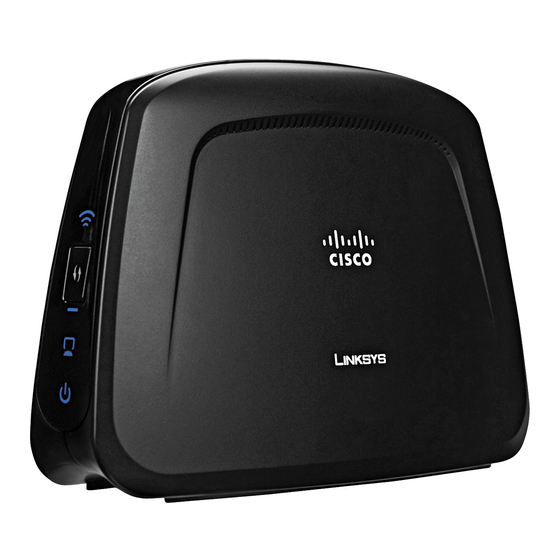Cisco Linksys WAP610N Kullanıcı Kılavuzu - Sayfa 22
Kablosuz Erişim Noktası Cisco Linksys WAP610N için çevrimiçi göz atın veya pdf Kullanıcı Kılavuzu indirin. Cisco Linksys WAP610N 41 sayfaları. Wireless-n access point with dual-band
Ayrıca Cisco Linksys WAP610N için: Hızlı Kurulum Kılavuzu (8 sayfalar)

Appendix D
Industry Canada Statement
This Class B digital apparatus complies with Canadian
ICES-003 and RSS210.
Operation is subject to the following two conditions:
1. This device may not cause interference and
2. This device must accept any interference, including
interference that may cause undesired operation of
the device.
Industry Canada Radiation Exposure Statement:
This equipment complies with IC radiation exposure limits
set forth for an uncontrolled environment. End users must
follow the specific operating instructions for satisfying
RF exposure compliance. To maintain compliance with
IC RF exposure compliance requirements, please follow
operation instruction as documented in this manual.
This transmitter must not be co-located or operating in
conjunction with any other antenna or transmitter.
Restrictions in the 5 GHz Band
1. The device for the band 5150-5250 MHz is only
for indoor usage to reduce potential for harmful
interference to co-channel mobile satellite systems.
2. This device has been designed to operate with an
antenna having a maximum gain of 1.58 dBi and
1.45 dBi at 2.4 GHz and 5 GHz respectively. Antenna
having a higher gain is strictly prohibited per
regulations of Industry Canada. The required antenna
impedance is 50 ohms.
3. The maximum antenna gain (please see the
table below) permitted (for devices in the bands
5250-5350 MHz and 5470-5725 MHz) to comply with
the E.I.R.P. limit:
For
Antenna
2.4 GHz
No.
Type
Gain (dBi)
1
PIFA
1.58
2
Printed
1.58
3
PIFA
1.58
Because high power radars are allocated as primary users
(meaning they have priority) in 5250-5350 MHz and
5650-5850 MHz, these radars could cause interference
and/or damage to licensed exempt LAN devices.
Additional requirements for the band 5600-5650 MHz:
Until further notice, devices subject to this Section shall
not be capable of transmitting in the band 5600-5650 MHz,
so that Environment Canada weather radars operating in
this band are protected.
Wireless-N Access Point with Dual-Band
For
5 GHz
Antenna
Gain (dBi)
Connector
1.45
N/A
1.45
N/A
1.45
N/A
Regulatory Information
Avis d'Industrie Canada
Cet appareil numérique de la classe B est conforme aux
normes NMB-003 et RSS210 du Canada.
L'utilisation de ce dispositif est autorisée seulement aux
conditions suivantes :
1. il ne doit pas produire de brouillage et
2. il doit accepter tout brouillage radioélectrique reçu,
même si ce brouillage est susceptible de compromettre
le fonctionnement du dispositif.
Avis d'Industrie Canada concernant l'exposition
aux radiofréquences :
Ce matériel est conforme aux limites d'exposition aux
radiofréquences établies par Industrie Canada pour un
environnement non contrôlé. L'opérateur doit suivre les
instructions d'utilisation décrites dans le présent manuel
afin de maintenir la conformité de l'installation.
L'émetteur ne doit pas être placé près d'une autre antenne
ou d'un autre émetteur, ou fonctionner avec une autre
antenne ou un autre émetteur.
Restrictions dans la bande 5 GHz
1. L'appareil pour la bande de 5 150 à 5 250 MHz est
conçu pour usage à l'intérieur seulement afin de
réduire le potentiel d'interférences pour les systèmes
mobiles par satellite qui utilisent le même canal.
2. Cet appareil est conçu pour fonctionner avec une
antenne ayant un gain maximal de 1,58 dBi à 2,4 GHz
et de 1,45 dBi à 5 GHz. Les antennes ayant un gain plus
élevé sont strictement interdites par Industrie Canada.
L'impédance d'antenne requise est de 50 ohms.
3. Le tableau ci-dessous indique le gain d'antenne
maximal pour les bandes 5 250-5 350 MHz et 5 470-
5 725 MHz afin d'assurer la conformité aux limites PIRE :
Pour
gain de
Type
2,4 GHz
N°
d'antenne
(dBi)
1
PIFA
1,58
2
À circuits
1,58
imprimés
3
PIFA
1,58
Du fait que les radars haute puissance ont la priorité
dans les bandes 5 250-5 350 MHz et 5 650-5 850 MHz, ils
pourraient causer des interférences ou endommager les
périphériques réseau sans fil.
Autres restrictions pour la bande 5 600-5 650 MHz : sauf
avis contraire, les périphériques concernés par cette
Pour
gain de
5 GHz
Connecteur
(dBi)
d'antenne
1,45
S.O.
1,45
S.O.
1,45
S.O.
19
